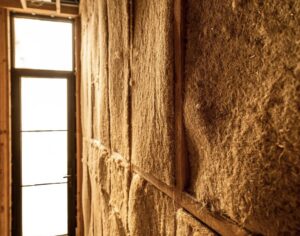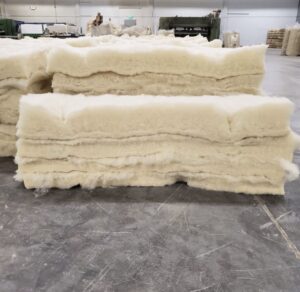
Are There Healthier Insulation Alternatives?
July 8, 2024
One area of sustainable building practices where we can make a significant difference is in home insulation. Traditional insulation materials like fiberglass and foam are effective but often come with a hefty environmental cost, both in their production and disposal. Fortunately, there are several eco-friendly alternatives. We have stocked UltraTouch Recycled Denim insulation since 2007 until they stopped production in the Spring of 2021. We are excited to have cotton batt insulation back as an option! The other two healthy options on the market are Hempitecture’s Hemp insulation and Havelock’s Wool Insulation. All three are great options and offer excellent insulation properties with a much smaller environmental footprint.
Why Insulation Matters
Before diving into the alternatives, it’s essential to understand why insulation is so crucial. Proper insulation helps maintain a comfortable indoor temperature, reducing the need for heating and cooling. This, in turn, lowers energy consumption and utility bills, while also decreasing greenhouse gas emissions. By choosing sustainable insulation materials, you can enhance these benefits and contribute to a healthier planet.
Cotton
UltraTouch recycled denim insulation is a fantastic eco-friendly option, made from 85% post-consumer recycled denim, which diverts waste from landfills and repurposes old jeans. Unlike traditional fiberglass insulation, UltraTouch is non-toxic and free from harmful chemicals and irritants, making it safer to handle during installation and healthier for indoor air quality. It excels in sound absorption, perfect for creating quieter and more peaceful living spaces. In terms of thermal performance, UltraTouch provides excellent insulation, helping to maintain consistent indoor temperatures and improve energy efficiency.
UltraTouch meets stringent fire safety standards. It is treated with a fire retardant borate solution to achieve a Class A fire rating, which means it has a low flame spread and smoke development index. This same fire retardant solution also enhances its resistance to mold, mildew, and pests helping to maintain indoor air quality and prolong the lifespan of the insulation. Additionally, it is easy to install, as the material can be easily cut and fitted into spaces without the need for special tools or protective gear, making it a convenient option for DIY projects. No breathing in small fibers or getting itchy from touching fiberglass.
The biggest advantage in Arizona is that it is made in Chandler, so it is a product made within 100 miles. This allows for transportation costs to be extremely low and to support a local business.
Hemp
Hempitecture HempWool batt insulation is another incredible option. Unlike traditional crops, hemp grows rapidly, is naturally resistant to pests, and requires far less water to grow well. During its cultivation process, the hemp plant absorbs carbon dioxide from the atmosphere, effectively sequestering carbon and mitigating greenhouse gases. The manufacturing of HempWool involves minimal energy use compared to the production of fiberglass and other synthetic insulations, which typically require significant amounts of fossil fuels.
Additionally, hemp insulation is easy to install, non-toxic, and biodegradable, ensuring a safer and more responsible choice for both builders and homeowners alike. Hempwool’s natural flexibility and resilience make it an ideal choice as it conforms easily to irregular spaces and curves without compromising its insulating effectiveness. HempWool® stands out as the healthiest insulation option available, composed of 90% hemp fiber and a non-toxic binder that ensures it’s safe to handle without gloves. Unlike competitors laden with harmful chemicals, HempWool® provides peace of mind with its natural, breathable composition. Its unique pressure fit system prevents slumping or sagging, ensuring consistent thermal and acoustic performance over time. Hemp insulation boasts excellent thermal and acoustic properties, offering superior heat retention in winter and cooling in summer. Its natural moisture-wicking abilities prevent mold growth and maintain indoor air quality, promoting healthier living environments.
Wool
Wool, commonly known for its use in textiles, is another excellent insulation material due to its numerous beneficial properties. As a renewable and sustainable resource, wool is harvested from sheep annually, supporting sustainable farming practices and reducing reliance on non-renewable resources.
Its insulating properties stem from the natural crimp in the fibers that traps air, providing excellent thermal insulation to keep homes warm in winter and cool in summer. Additionally, wool can absorb up to 35% of its weight in moisture without compromising its insulating capabilities, making it ideal for regulating indoor humidity levels and prevent issues like mold and mildew growth. Wool naturally filters air by absorbing and neutralizing harmful chemicals and pollutants, such as formaldehyde, nitrogen dioxide, and sulfur dioxide. Due to its high nitrogen and water content, it is naturally fire-resistant.
Wool has a high ignition temperature and self-extinguishing properties, adding an extra layer of safety to your home without the need for chemical fire retardants. Furthermore, wool insulation is biodegradable, meaning it can be composted at the end of its life cycle, returning to the earth without leaving harmful residues. Havelock Wool Insulation is available in batts and loose-fill forms, making it versatile for various applications, including walls, floors, ceilings, and attics. It is easy to handle and install, often without the need for protective equipment.
Comparing the Alternatives
All three of these alternative insulation materials offer compelling advantages over traditional insulation. Their sustainable sourcing and eco-friendly properties not only reduce environmental impact but also enhance the health and safety of indoor spaces. They can be handled without protective gear, making them an excellent choice for not just DIYers, but anyone installing insulation. No more fiberglass itch or toxic chemicals hiding in your walls! By opting for these innovative insulation materials, you contribute to a more sustainable future while enjoying the benefits of improved energy efficiency, lower utility bills, and a healthier living environment. Whether you choose Havelock wool, Hempitecture’s HempWool, or UltraTouch recycled denim, you’re making a positive impact on both your home and the planet. Embrace these eco-friendly insulation alternatives and take a meaningful step towards a greener, more sustainable lifestyle.



